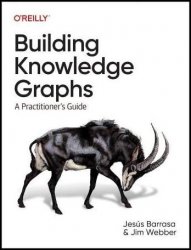Building Knowledge Graphs: A Practitioner's Guide (Final)
- Добавил: literator
- Дата: 30-09-2023, 05:12
- Комментариев: 0
 Название: Building Knowledge Graphs: A Practitioner's Guide (Final)
Название: Building Knowledge Graphs: A Practitioner's Guide (Final)Автор: Jesus Barrasa, Maya Natarajan, Jim Webber
Издательство: O’Reilly Media, Inc.
Год: 2023
Страниц: 291
Язык: английский
Формат: True PDF, True EPUB (Retail Copy)
Размер: 28.5 MB
Incredibly useful, knowledge graphs help organizations keep track of medical research, cybersecurity threat intelligence, GDPR compliance, web user engagement, and much more. They do so by storing interlinked descriptions of entities—objects, events, situations, or abstract concepts—and encoding the underlying information. How do you create a knowledge graph? And how do you move it from theory into production?
Graph data has become ubiquitous in the last decade. Graphs underpin everything from consumer-facing systems like navigation and social networks to critical infrastructure like supply chains and policing. A consistent theme has emerged: applying knowledge in context is the single most powerful tool that most businesses have. Through research and experience, a set of patterns and practices called knowledge graphs has been developed to support extracting knowledge from data of all types and in all sources, from systems of record to frozen data lakes to application logs. This book is for information technology professionals who are interested in building and operating knowledge graphs within their businesses.
Using hands-on examples, this practical book shows data scientists and data engineers how to build their own knowledge graphs. Authors Jesus Barrasa and Jim Webber from Neo4j illustrate common patterns for building knowledge graphs that solve many of today’s pressing knowledge management problems. You’ll quickly discover how these graphs become increasingly useful as you add data and augment them with algorithms and Machine Learning.
Importantly, while the term knowledge graph has only come to prominence in industry relatively recently, knowledge graph systems have been in existence for some time. This book tries to distill our experience of understanding knowledge graphs deployed in real systems by organizations around the world. It addresses the emerging trend of building systems on knowledge graphs as well as thinking about knowledge graphs as a general-purpose underlay for the enterprise. It also addresses the contemporary intersection of knowledge graphs and artificial intelligence (AI), where knowledge graphs provide high-quality features for Machine Learning, are themselves enriched by AI, and can even tame the hallucinatory nature of large language models (LLMs).
Learn the organizing principles necessary to build a knowledge graph
Explore how graph databases serve as a foundation for knowledge graphs
Understand how to import structured and unstructured data into your graph
Follow examples to build integration-and-search knowledge graphs
Learn what pattern detection knowledge graphs help you accomplish
Explore dependency knowledge graphs through examples
Use examples of natural language knowledge graphs and chatbots
Use graph algorithms and ML to gain insight into connected data
Скачать Building Knowledge Graphs: A Practitioner's Guide (Final)
Внимание
Уважаемый посетитель, Вы зашли на сайт как незарегистрированный пользователь.
Мы рекомендуем Вам зарегистрироваться либо войти на сайт под своим именем.
Уважаемый посетитель, Вы зашли на сайт как незарегистрированный пользователь.
Мы рекомендуем Вам зарегистрироваться либо войти на сайт под своим именем.
Информация
Посетители, находящиеся в группе Гости, не могут оставлять комментарии к данной публикации.
Посетители, находящиеся в группе Гости, не могут оставлять комментарии к данной публикации.
